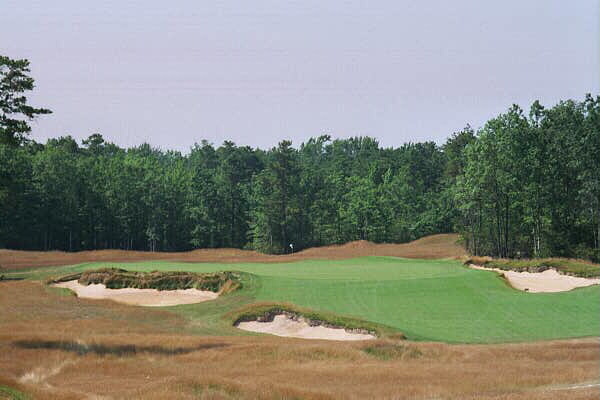Surface Drainage--A timeless method of influencing the direction of drain waterI think it's a common misconception of many modern architects that the old guys didn't know how to make water drain. I've seen it and I believe in it and the proof I offer, Riviera and Bel Air. Both of these sites have drainage going to one focal point--the low point of the property. If your ever at Riviera #6, go look to the far extreme right towards the ocean and you'll see an old iron drain that Billy Bell himself specified. o can find one at the bottom of the southwest end of the Arizona Biltmore and used to be able to find one emptying into the old reservoir which is now the driving range at Bel Air too.
Recently we had a thread asking if most GCA aficionados could tell good shaping from natural lay of the land. The response were dismal at best, as most couldn't nor cared to. (time prevented me from further elaborating, but hopefully this thread will suffice) I can only hope that most of you, the next time your at your faovrite course designed by some old dead guy, look at the differences of how these features were used to divert water without the use of a underground pipe.
You see, I think this is the certain charm of our timeless classics--how the lay of the land; it's features and for the most part the ability to drain water from these features that all define the golf hole itself. Getting back to Riviera and Bel Air as examples, these courses have one direct drain point, all of them obviously down their descriptive canyons which are
ingeniously fed from all sorts of different points from around the golf course. Usually high points from around the golf hole and features themselves.
These barranca/arroyo/creek-like features are the involved strategies. They help make these courses great or respected or whatever Jeff Brauer wants to call it. How are you going to do that with a pipe that is buried in the ground? That grassy Hollow which feeds that pipe is for me, unsightly, unnatural and just plain foolish in what it costs to build it from shaping to putting in the ABS plastic drain which will get broken the first mower, golf cart or 6 iron that makes contact with it. These pipes also clog with leaves, branches and other debris. This is usually when the Golf Course Superintendent would love ot get a hold of Mr. Brauer for specing that particular type of drainage.
But the point here is not that they are without merit when they are needed, it's the reliance on these collection areas, becoming an architect's best friend so-to-speak. There are just so many architects using them nowadays. they just use them WAY too much and way too freely. The bad side to this is that this drainage adds to the cost of building an affordable links, let alone an intelligent one.
Dr. Brauer implies,
The advent of PVC drain pipe makes installation cheaper then ever, raising it's cost/benefit ratio to where it makes no sense not to use it.....This is precisely the point where I think many modern golf architects lose sight of the art of designing golf courses artistically, scientifically and just using plain common sense. The cheapest way to get good drainage is not to use PVC pipe just because it and it's installation cost are a benefit, (the entire gist of his article) it's only affordable to use it when it needs to be used. The cost of labor to install which requires a crew to not only assemble lengthy stretches of PVC pipe, a man on a tractor/backhoe to utilize a trenching device which actually pulls it in, or if it's installed by a crew by hand is in no way comparable in price.
AS IN THERE IS NO BENEFIT! (Mr. Brauer can argue this as much as he wants, because I have an electrical career full of trenches and pipes which to compare!) figure this for the amount of catch basins per hole and multiply it by 18, not counting a driving range or practice areas where they use them too, well your talking a lot of money when compared to a man on a bulldozer who is artfully creating surface drainage that has been designed by an architect who knows what he is doing, and after all, he's going to be out there shaping the ground anyway.
It's all common sense.
While I applaud Jeff Brauer's abilities to discern what's best and speculates what he thinks our famous great would have done today, I can assure you common sense did get the best of them after a Great Depression and a World War when financial survival mattered most. That much is for sure. Economy simply killed them and their spirit till our great architects of today who studied and emulated them brought them back alive. Look at the top ten of the Golfweek Modern list and tell me different.
While Jeff Brauer maintains that the owners and bankers know the value of good drainage to a golf course business plan, then please explain to me why so many new courses have closed because the property became more valuable then the risk of building the golf course and the costs involved?
The rest of Jeff's article is filled with the typical challenges of 'what we face against what the golden age guys did'-type of scenarios which I grow increasingly tired of with each new article, some of it may have merit, but only if you plan on having a golf course that will be about as natural as Anna Nicole Smith's breast--with houses on it. But still, I shudder to think of the time Geoff, the creator of the very article which Mr. Brauer criticizes, explained to me some years ago, when he was working at Riviera, and still in the somewhat good graces of the Watanabe family, he looked outside and saw it raining. He looked to see like he had done so many rainstorms before how the water was running through those thoughtfully constructed barrancas, but on this occasion, shortly after Poly Vinyl Chloride piping had been installed in those barrancas, that the water now started coagulating and wasn't moving like it once did before. The last time I was at the Nissan Open, it was raining and it too was the first thing that caught my eye.
George Thomas, welcome home....
No catch basins here...

Here either...
